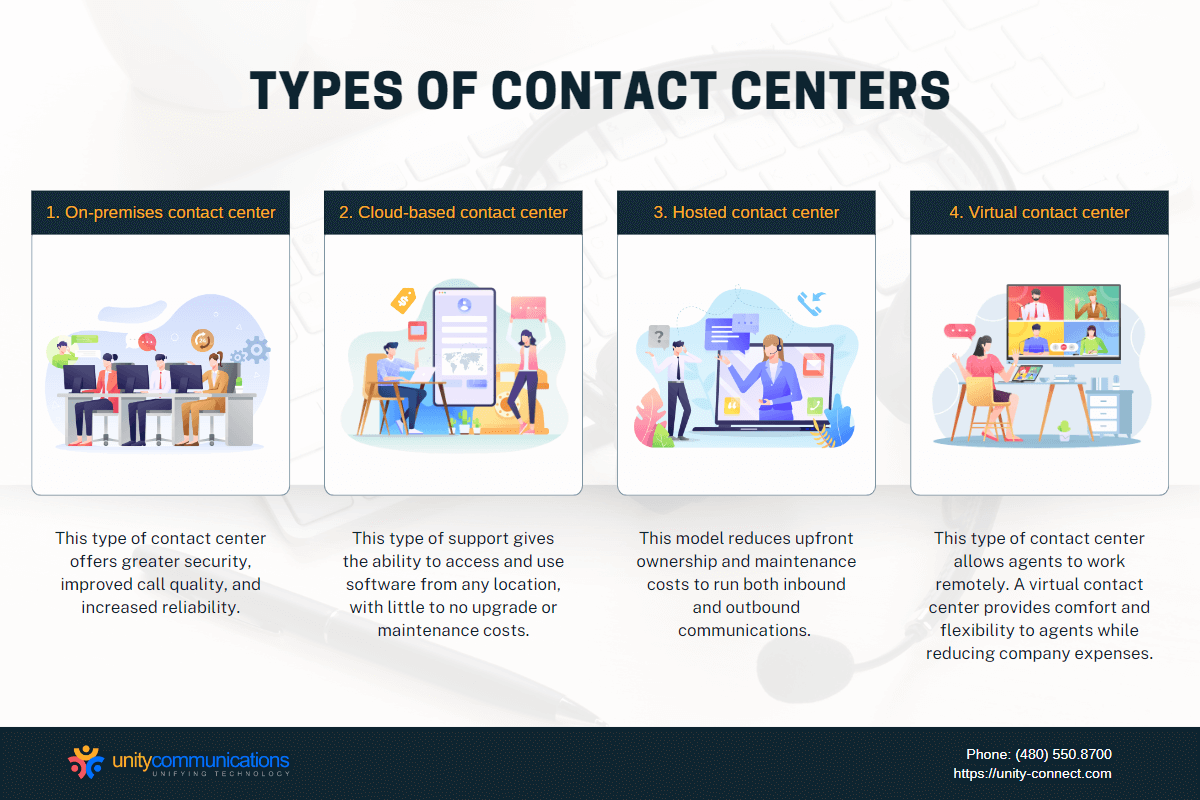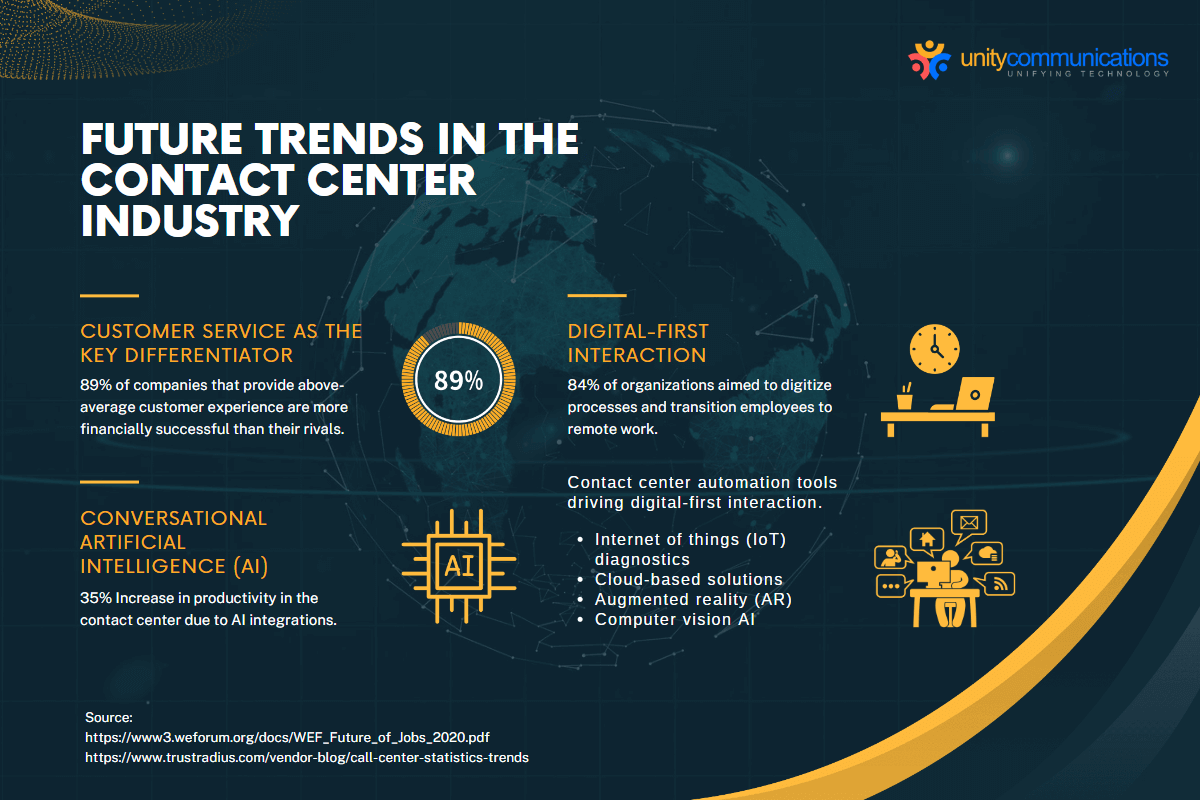Table of Contents
Customer demands and touchpoints are increasingly complex. Customer service departments must evolve beyond the legacy call center to a call center as a service (CCaaS). A thriving customer support department adopts its clients’ most used channels. It then goes above and beyond to deliver unique experiences.
Contact centers are the norm, making it easier for businesses to reach and interact with consumers.
This article discusses the contact center industry and how it operates. We will also explore the different types of contact centers, the various sectors that use them, and industry trends.
What Is a Contact Center?

A contact center is a remote or centralized managed facility that receives and transmits inquiries via phone calls, chat, email, or SMS. It is a primary point where brands oversee all customer interactions across many channels. Its main goal is to deliver quick and effective customer service, tech support, and sales assistance.
Typically, contact centers include one or more call centers. But they can also involve other customer service platforms such as web chat, social media, and email. Furthermore, companies integrate their contact centers with a customer relationship management (CRM) strategy.
Contact centers are becoming increasingly important. More consumers expect businesses to be constantly available on various channels. The contact center industry takes an omnichannel approach, which allows you to increase efficiency, refine service quality, enhance insight into customer needs and behavior, and create better experiences.
Contact Centers vs. Call Centers
Call centers and contact centers are both customer service centers. But the two terms are not interchangeable. A call center handles only inbound or outbound tickets. Meanwhile, a contact center provides omnichannel customer support.
Here’s a more detailed look at the differences between a contact center and a call center.
Channels
Call centers service inbound and outbound calls from clients. Legacy call center agents handle customer inquiries, telemarketing, billing, debt collections, and other client-facing functions. A call center operation can be based within the organization or contracted to a business process outsourcing company.
Conversely, a contact center manages inbound and outbound customer interaction. Contact center functions can be managed in-house or outsourced to a third-party provider. Unlike their legacy counterparts, contact center agents interact with consumers across various platforms such as apps, messaging, phones, social media, and the web.
Management
A contact center manages all customer contacts. It requires company-wide integration and coordination of people, technology, and processes. For instance, managers train agents in each communication channel’s best practices. Contact center teams also adapt performance metrics for each platform to account for their different capabilities and functions.
Legacy call centers use traditional metrics such as average handle time (AHT). Such metrics are not relevant to other channels, such as mobile messaging.
What Are the Types of Contact Centers?

The contact center industry comprises several types of centers, including hardware, hosted, cloud-based, and virtual. Companies can use each type of contact center depending on the need. Explore the features of each contact center model.
- Hardware contact center. Organizations can deploy and host hardware contact centers on premises-based servers. Companies must have enough capacity and space to house and maintain the servers. Lastly, a competent hardware update process and robust disaster recovery plan are necessary.
- Cloud-based contact center. The internet servers of cloud providers host this type of contact center. A cloud provider filters inbound and outbound communication. Cloud-based contact center agents can access the system with a strong internet connection.
- Hosted contact center. This contact center involves outsourcing the infrastructure to an external vendor that maintains the system in-house. This model can reduce maintenance and costs upfront, resulting in a better return on investment.
- Virtual contact center. This type of contact center allows agents to work remotely. A virtual contact center provides comfort and flexibility to agents while reducing company expenses.
Choosing a type of contact center starts by checking the product offered and exploring the functionality of each approach. Check the tools and technology that agents will need. Lastly, identify all the customer relationship management integrations necessary to support customer data collection.
How Do Contact Centers Work?

Contact centers today are increasingly leveraging omnichannel customer engagement strategies, encompassing voice over internet protocol (VoIP), chat, website, or email support. According to Zendesk’s Customer Experience Trends Report 2023, 81% of business leaders now recognize the growing importance of customer experience and support, highlighting the shift towards more integrated and responsive customer service platforms.
When encountering a “Contact Us” or customer service tab on a website, these typically connect users to a contact center where agents handle various tasks, from resolving complaints to client acquisition.
The core objective of the contact center industry is to ensure customer satisfaction and happiness. Key features of a modern contact center include:
- Automatic call distributor (ACD). Enhances the number of calls agents can handle while maintaining a high-quality customer experience.
- Real-time reports. This allows managers to monitor agent performance and customer satisfaction across real-time platforms.
- Scripts. Provide a structured approach for agents to assist customers effectively.
- Interchangeable assignments. Enable agents to share contacts and tasks while operating from individual stations.
- Live agent chat. Facilitates direct communication with customers through internal messaging systems for inquiries about accounts, order statuses, and more.
- Help desk agents. Address client calls, troubleshoot issues, and escalate complex tickets to specialized technicians.
- Telemarketing agents. These agents use leads to contact prospects and promote products or services as part of the outbound team.
What Are the Different Industries That Use Contact Centers?

Sectors such as finance, ecommerce, retail, healthcare, and travel rely on the contact center industry to manage customer interactions. These sectors use contact center services to retain customers and make more money.
Others acquire contact center services to streamline daily tasks. For instance, insurance and telecommunications use customer support solutions to ease complex processes and provide beneficial services for customers.
Here’s a breakdown of the various sectors that rely on contact centers and how they use services.
Healthcare
A high-tech and digital customer experience model gains market share and increases revenue in a stiff healthcare market. Contact centers provide a unified system for distributed networks because most medical companies have a large presence with facilities, hospitals, and diagnostic clinics in several places.
Most healthcare providers use contact center technologies to deliver a personalized experience. Patients can use their preferred channels to access appointment notifications, communication, and billing details.
Banking and Financial Sector
Banking and financial services rely on the contact center industry to maintain and manage loan offerings and policy inquiries regarding government rules and updates, taxes, and more.
Automation with contact center software makes banking and financial services more accessible. Features such as conversation history and call recording also help banks keep transcripts of interactions for future review. Contact center agents have information and scripts to make interacting with customers a breeze.
Banking institutions that outsource customer support include:
- Bank of America
- Wells Fargo & Company
- JPMorgan Chase
- Prudential Financial
- Capital One
Automotive Sector
In the automotive industry, contact centers play a crucial role in enhancing customer experience and loyalty. According to Twilio’s 2023 State of Customer Engagement Report, 66% of consumers say they will leave a brand if their experience isn’t personalized.
Contact centers enable automotive businesses to offer tailored post-sale support, schedule maintenance services, and provide exclusive offers, thereby fostering customer retention and satisfaction.
Retail Sector
The competition in retail and ecommerce is tough. Brands that sell similar products saturate the market. Thus, gaining a competitive advantage is one of the reasons retail and ecommerce companies rely on the contact center industry.
Contact center solutions help retail businesses with lead generation, customer service, and market research. A contact center handles all customer inquiries, complaints, direct responses, order processing, and more.
Retail and ecommerce companies that outsource customer support include:
- Amazon
- Target
Utility Sector
Utility companies are consumer-facing, which means they deal with numerous customer calls. Tickets can range from billing inquiries and payment and credit to service requests and connection assistance requests.
Popular utility companies that use contact center solutions are:
- Enel Energia
- Dominion Energy
- Entergy Corporation
Telecommunications
The telecom industry faces tough competition because internet services and low prices are the norms. Staying ahead of the crowd requires excellent customer service because customers won’t hesitate to change their service provider given that options abound.
Due to their massive consumer base, phone companies get thousands of customer tickets daily. Callers inquire about billing, service outages, and more. A contact center simplifies tasks and is crucial in managing customer tickets.
Telecom companies that outsource customer support are:
- AT&T
- Verizon
- Telstra
- Comcast
- Vodafone
- Telefónica
The Future and Trends of the Contact Center Industry

The contact center industry saw the rise of virtual assistance and omnichannel support and even the start of the metaverse in the past decade. The development of CX-driven disruptors and the adoption of new technologies drive the expectations of modern customers.
As new realities unfold, imagining what lies ahead for customer service and contact centers is interesting. Let’s look at the contact center trends to keep an eye on.
Customer Service as the Key Differentiator
In today’s market, customer service is a critical differentiator for brands. As previously mentioned, 81% of business leaders now see customer experience and support as increasingly important. Key issues impacting customer loyalty include:
- Impersonal experiences. Twilio’s report reveals that 66% of consumers will likely switch brands if the experience isn’t personalized.
- Communication challenges. Ozonetel’s 2024 report shows a significant improvement in contact centers with an 80% call answer rate, addressing previous issues of communication dead ends.
- Human interaction demands. The desire for human connection remains strong, with customers often preferring to speak directly to agents.
- Ineffective self-help options. Customers expect efficient self-help options that seamlessly integrate with agent support when needed.
- Extended waiting times. Long wait times are a major frustration, emphasizing the need for efficient call handling and callback options.
- Misdirection in call routing. Accurate and efficient call routing is essential to quickly connecting customers to the right support.
- Repetition in AI interactions. Integration between AI and human agents needs to be seamless to avoid customers having to repeat information.
- Flexibility in communication channels. Customers place increasing value on the ability to switch between various communication platforms.
In the digital age, businesses must prioritize customer service quality to maintain their online reputation and customer loyalty.
Digital-first Interaction
The trend towards digital-first interactions in customer service has been steadily growing. Twilio’s report indicates that investment in digital customer engagement has led to an average revenue increase of 90%, reflecting the significant impact of digital transformation. The emergence of cutting-edge contact center automation tools, rising customer expectations, and the complexity of customer cases have all influenced the shift to remote assistance. Key examples of these tools include:
- Internet of Things (IoT) diagnostics. IoT technology enables proactive issue resolution and real-time customer support.
- Cloud-based solutions. The efficiency of customer service and response times have increased thanks to cloud-based contact centers, as Ozonetel’s 2024 report emphasizes.
- Augmented reality (AR): AR provides immersive support experiences, allowing customers to visualize solutions in real time.
- Computer vision AI. This technology enhances customer interactions by providing intelligent visual assistance and analysis.
These advancements underscore the evolving landscape of customer service, where digital-first strategies are becoming essential for effective and efficient customer engagement.
Conversational Artificial Intelligence (AI)
Conversational AI uses advanced analytics strategies for voice and text interactions. Meanwhile, conversational AI uses AI-powered voice bots and chatbots. AI automates many query resolutions, especially for recurring problems and frequently asked questions (FAQs). Conversational AI accomplishes simple activities such as order cancellation with an intuitive chat flow.
Both contact center technologies benefit from further developments in data processing.
The Bottom Line
The contact center industry offers companies a view into their customer interaction, allowing them to solve issues quickly without asking callers to repeat themselves or wait on hold for a long.
Contact centers allow you to connect with consumers using various digital platforms and obtain more insights into their preferences, buying behaviors, and needs. The analytics feature helps you monitor and assess key platform consumer experience metrics.
Combining various types of support, proactive engagement, empowered agents, and personalized experience, build a dynamic department capable of maintaining customer loyalty that will pay dividends.




